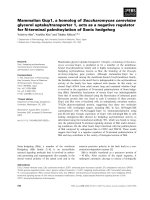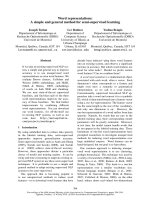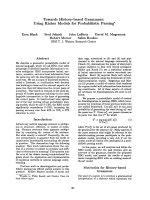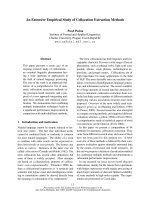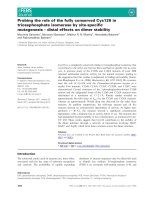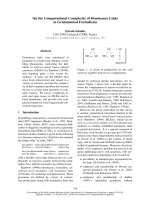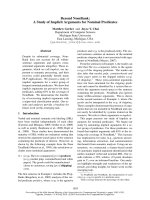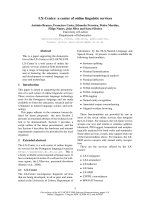Báo cáo khoa học: "Beyond NomBank: A Study of Implicit Arguments for Nominal Predicates" doc
Bạn đang xem bản rút gọn của tài liệu. Xem và tải ngay bản đầy đủ của tài liệu tại đây (169.53 KB, 10 trang )
Proceedings of the 48th Annual Meeting of the Association for Computational Linguistics, pages 1583–1592,
Uppsala, Sweden, 11-16 July 2010.
c
2010 Association for Computational Linguistics
Beyond NomBank:
A Study of Implicit Arguments for Nominal Predicates
Matthew Gerber and Joyce Y. Chai
Department of Computer Science
Michigan State University
East Lansing, Michigan, USA
{gerberm2,jchai}@cse.msu.edu
Abstract
Despite its substantial coverage, Nom-
Bank does not account for all within-
sentence arguments and ignores extra-
sentential arguments altogether. These ar-
guments, which we call implicit, are im-
portant to semantic processing, and their
recovery could potentially benefit many
NLP applications. We present a study of
implicit arguments for a select group of
frequent nominal predicates. We show that
implicit arguments are pervasive for these
predicates, adding 65% to the coverage of
NomBank. We demonstrate the feasibil-
ity of recovering implicit arguments with
a supervised classification model. Our re-
sults and analyses provide a baseline for
future work on this emerging task.
1 Introduction
Verbal and nominal semantic role labeling (SRL)
have been studied independently of each other
(Carreras and M
`
arquez, 2005; Gerber et al., 2009)
as well as jointly (Surdeanu et al., 2008; Haji
ˇ
c et
al., 2009). These studies have demonstrated the
maturity of SRL within an evaluation setting that
restricts the argument search space to the sentence
containing the predicate of interest. However, as
shown by the following example from the Penn
TreeBank (Marcus et al., 1993), this restriction ex-
cludes extra-sentential arguments:
(1) [arg
0
The two companies] [pred produce]
[arg
1
market pulp, containerboard and white
paper]. The goods could be manufactured
closer to customers, saving [pred shipping]
costs.
The first sentence in Example 1 includes the Prop-
Bank (Kingsbury et al., 2002) analysis of the ver-
bal predicate produce, where arg
0
is the agentive
producer and arg
1
is the produced entity. The sec-
ond sentence contains an instance of the nominal
predicate shipping that is not associated with argu-
ments in NomBank (Meyers, 2007).
From the sentences in Example 1, the reader can
infer that The two companies refers to the agents
(arg
0
) of the shipping predicate. The reader can
also infer that market pulp, containerboard and
white paper refers to the shipped entities (arg
1
of shipping).
1
These extra-sentential arguments
have not been annotated for the shipping predi-
cate and cannot be identified by a system that re-
stricts the argument search space to the sentence
containing the predicate. NomBank also ignores
many within-sentence arguments. This is shown
in the second sentence of Example 1, where The
goods can be interpreted as the arg
1
of shipping.
These examples demonstrate the presence of argu-
ments that are not included in NomBank and can-
not easily be identified by systems trained on the
resource. We refer to these arguments as implicit.
This paper presents our study of implicit ar-
guments for nominal predicates. We began our
study by annotating implicit arguments for a se-
lect group of predicates. For these predicates, we
found that implicit arguments add 65% to the ex-
isting role coverage of NomBank.
2
This increase
has implications for tasks (e.g., question answer-
ing, information extraction, and summarization)
that benefit from semantic analysis. Using our an-
notations, we constructed a feature-based model
for automatic implicit argument identification that
unifies standard verbal and nominal SRL. Our re-
sults indicate a 59% relative (15-point absolute)
gain in F
1
over an informed baseline. Our analy-
ses highlight strengths and weaknesses of the ap-
proach, providing insights for future work on this
emerging task.
1
In PropBank and NomBank, the interpretation of each
role (e.g., arg
0
) is specific to a predicate sense.
2
Role coverage indicates the percentage of roles filled.
1583
In the following section, we review related re-
search, which is historically sparse but recently
gaining traction. We present our annotation effort
in Section 3, and follow with our implicit argu-
ment identification model in Section 4. In Section
5, we describe the evaluation setting and present
our experimental results. We analyze these results
in Section 6 and conclude in Section 7.
2 Related work
Palmer et al. (1986) made one of the earliest at-
tempts to automatically recover extra-sentential
arguments. Their approach used a fine-grained do-
main model to assess the compatibility of candi-
date arguments and the slots needing to be filled.
A phenomenon similar to the implicit argu-
ment has been studied in the context of Japanese
anaphora resolution, where a missing case-marked
constituent is viewed as a zero-anaphoric expres-
sion whose antecedent is treated as the implicit ar-
gument of the predicate of interest. This behavior
has been annotated manually by Iida et al. (2007),
and researchers have applied standard SRL tech-
niques to this corpus, resulting in systems that
are able to identify missing case-marked expres-
sions in the surrounding discourse (Imamura et
al., 2009). Sasano et al. (2004) conducted sim-
ilar work with Japanese indirect anaphora. The
authors used automatically derived nominal case
frames to identify antecedents. However, as noted
by Iida et al., grammatical cases do not stand in
a one-to-one relationship with semantic roles in
Japanese (the same is true for English).
Fillmore and Baker (2001) provided a detailed
case study of implicit arguments (termed null in-
stantiations in that work), but did not provide con-
crete methods to account for them automatically.
Previously, we demonstrated the importance of fil-
tering out nominal predicates that take no local ar-
guments (Gerber et al., 2009); however, this work
did not address the identification of implicit ar-
guments. Burchardt et al. (2005) suggested ap-
proaches to implicit argument identification based
on observed coreference patterns; however, the au-
thors did not implement and evaluate such meth-
ods. We draw insights from all three of these
studies. We show that the identification of im-
plicit arguments for nominal predicates leads to
fuller semantic interpretations when compared to
traditional SRL methods. Furthermore, motivated
by Burchardt et al., our model uses a quantitative
analysis of naturally occurring coreference pat-
terns to aid implicit argument identification.
Most recently, Ruppenhofer et al. (2009) con-
ducted SemEval Task 10, “Linking Events and
Their Participants in Discourse”, which evaluated
implicit argument identification systems over a
common test set. The task organizers annotated
implicit arguments across entire passages, result-
ing in data that cover many distinct predicates,
each associated with a small number of annotated
instances. In contrast, our study focused on a se-
lect group of nominal predicates, each associated
with a large number of annotated instances.
3 Data annotation and analysis
3.1 Data annotation
Implicit arguments have not been annotated within
the Penn TreeBank, which is the textual and syn-
tactic basis for NomBank. Thus, to facilitate
our study, we annotated implicit arguments for
instances of nominal predicates within the stan-
dard training, development, and testing sections of
the TreeBank. We limited our attention to nom-
inal predicates with unambiguous role sets (i.e.,
senses) that are derived from verbal role sets. We
then ranked this set of predicates using two pieces
of information: (1) the average difference between
the number of roles expressed in nominal form (in
NomBank) versus verbal form (in PropBank) and
(2) the frequency of the nominal form in the cor-
pus. We assumed that the former gives an indica-
tion as to how many implicit roles an instance of
the nominal predicate might have. The product of
(1) and (2) thus indicates the potential prevalence
of implicit arguments for a predicate. To focus our
study, we ranked the predicates in NomBank ac-
cording to this product and selected the top ten,
shown in Table 1.
We annotated implicit arguments document-by-
document, selecting all singular and plural nouns
derived from the predicates in Table 1. For each
missing argument position of each predicate in-
stance, we inspected the local discourse for a suit-
able implicit argument. We limited our attention to
the current sentence as well as all preceding sen-
tences in the document, annotating all mentions of
an implicit argument within this window.
In the remainder of this paper, we will use iarg
n
to refer to an implicit argument position n. We
will use arg
n
to refer to an argument provided by
PropBank or NomBank. We will use p to mark
1584
Pre-annotation Post-annotation
Role average
Predicate # Role coverage (%) Noun Verb Role coverage (%) Noun role average
price 217 42.4 1.7 1.7 55.3 2.2
sale 185 24.3 1.2 2.0 42.0 2.1
investor 160 35.0 1.1 2.0 54.6 1.6
fund 109 8.7 0.4 2.0 21.6 0.9
loss 104 33.2 1.3 2.0 46.9 1.9
plan 102 30.9 1.2 1.8 49.3 2.0
investment 102 15.7 0.5 2.0 33.3 1.0
cost 101 26.2 1.1 2.3 47.5 1.9
bid 88 26.9 0.8 2.2 72.0 2.2
loan 85 22.4 1.1 2.5 41.2 2.1
Overall 1,253 28.0 1.1 2.0 46.2 1.8
Table 1: Predicates targeted for annotation. The second column gives the number of predicate instances
annotated. Pre-annotation numbers only include NomBank annotations, whereas Post-annotation num-
bers include NomBank and implicit argument annotations. Role coverage indicates the percentage of
roles filled. Role average indicates how many roles, on average, are filled for an instance of a predicate’s
noun form or verb form within the TreeBank. Verbal role averages were computed using PropBank.
predicate instances. Below, we give an example
annotation for an instance of the investment predi-
cate:
(2) [iarg
0
Participants] will be able to transfer
[iarg
1
money] to [iarg
2
other investment
funds]. The [p investment] choices are
limited to [iarg
2
a stock fund and a
money-market fund].
NomBank does not associate this instance of in-
vestment with any arguments; however, we were
able to identify the investor (iarg
0
), the thing in-
vested (iarg
1
), and two mentions of the thing in-
vested in (iarg
2
).
Our data set was also independently annotated
by an undergraduate linguistics student. For each
missing argument position, the student was asked
to identify the closest acceptable implicit argu-
ment within the current and preceding sentences.
The argument position was left unfilled if no ac-
ceptable constituent could be found. For a miss-
ing argument position, the student’s annotation
agreed with our own if both identified the same
constituent or both left the position unfilled. Anal-
ysis indicated an agreement of 67% using Cohen’s
kappa coefficient (Cohen, 1960).
3.2 Annotation analysis
Role coverage for a predicate instance is equal to
the number of filled roles divided by the number
of roles in the predicate’s lexicon entry. Role cov-
erage for the marked predicate in Example 2 is
0/3 for NomBank-only arguments and 3/3 when
the annotated implicit arguments are also consid-
ered. Returning to Table 1, the third column gives
role coverage percentages for NomBank-only ar-
guments. The sixth column gives role coverage
percentages when both NomBank arguments and
the annotated implicit arguments are considered.
Overall, the addition of implicit arguments created
a 65% relative (18-point absolute) gain in role cov-
erage across the 1,253 predicate instances that we
annotated.
The predicates in Table 1 are typically associ-
ated with fewer arguments on average than their
corresponding verbal predicates. When consid-
ering NomBank-only arguments, this difference
(compare columns four and five) varies from zero
(for price) to a factor of five (for fund). When im-
plicit arguments are included in the comparison,
these differences are reduced and many nominal
predicates express approximately the same num-
ber of arguments on average as their verbal coun-
terparts (compare the fifth and seventh columns).
In addition to role coverage and average count,
we examined the location of implicit arguments.
Figure 1 shows that approximately 56% of the im-
plicit arguments in our data can be resolved within
the sentence containing the predicate. The remain-
ing implicit arguments require up to forty-six sen-
1585
0.4
0.5
0.6
0.7
0.8
0.9
1
0 2 4 6 8 10 12 18 28 46
Sentences prior
Implicit arguments
resolved
Figure 1: Location of implicit arguments. For
missing argument positions with an implicit filler,
the y-axis indicates the likelihood of the filler be-
ing found at least once in the previous x sentences.
tences for resolution; however, a vast majority of
these can be resolved within the previous few sen-
tences. Section 6 discusses implications of this
skewed distribution.
4 Implicit argument identification
4.1 Model formulation
In our study, we assumed that each sentence in a
document had been analyzed for PropBank and
NomBank predicate-argument structure. Nom-
Bank includes a lexicon listing the possible ar-
gument positions for a predicate, allowing us to
identify missing argument positions with a simple
lookup. Given a nominal predicate instance p with
a missing argument position iarg
n
, the task is to
search the surrounding discourse for a constituent
c that fills iarg
n
. Our model conducts this search
over all constituents annotated by either PropBank
or NomBank with non-adjunct labels.
A candidate constituent c will often form a
coreference chain with other constituents in the
discourse. Consider the following abridged sen-
tences, which are adjacent in their Penn TreeBank
document:
(3) [Mexico] desperately needs investment.
(4) Conservative Japanese investors are put off
by [Mexico’s] investment regulations.
(5) Japan is the fourth largest investor in
[c Mexico], with 5% of the total
[p investments].
NomBank does not associate the labeled instance
of investment with any arguments, but it is clear
from the surrounding discourse that constituent c
(referring to Mexico) is the thing being invested in
(the iarg
2
). When determining whether c is the
iarg
2
of investment, one can draw evidence from
other mentions in c’s coreference chain. Example
3 states that Mexico needs investment. Example
4 states that Mexico regulates investment. These
propositions, which can be derived via traditional
SRL analyses, should increase our confidence that
c is the iarg
2
of investment in Example 5.
Thus, the unit of classification for a candi-
date constituent c is the three-tuple p, iarg
n
, c
,
where c
is a coreference chain comprising c and
its coreferent constituents.
3
We defined a binary
classification function P r(+| p, iarg
n
, c
) that
predicts the probability that the entity referred to
by c fills the missing argument position iarg
n
of
predicate instance p. In the remainder of this pa-
per, we will refer to c as the primary filler, dif-
ferentiating it from other mentions in the corefer-
ence chain c
. In the following section, we present
the feature set used to represent each three-tuple
within the classification function.
4.2 Model features
Starting with a wide range of features, we per-
formed floating forward feature selection (Pudil
et al., 1994) over held-out development data com-
prising implicit argument annotations from section
24 of the Penn TreeBank. As part of the feature
selection process, we conducted a grid search for
the best per-class cost within LibLinear’s logistic
regression solver (Fan et al., 2008). This was done
to reduce the negative effects of data imbalance,
which is severe even when selecting candidates
from the current and previous few sentences. Ta-
ble 2 shows the selected features, which are quite
different from those used in our previous work to
identify traditional semantic arguments (Gerber et
al., 2009).
4
Below, we give further explanations
for some of the features.
Feature 1 models the semantic role relationship
between each mention in c
and the missing argu-
ment position iarg
n
. To reduce data sparsity, this
feature generalizes predicates and argument posi-
tions to their VerbNet (Kipper, 2005) classes and
3
We used OpenNLP for coreference identification:
4
We have omitted many of the lowest-ranked features.
Descriptions of these features can be obtained by contacting
the authors.
1586
# Feature value description
1* For every f, the VerbNet class/role of p
f
/arg
f
concatenated with the class/role of p/iarg
n
.
2* Average pointwise mutual information between p, iarg
n
and any p
f
, arg
f
.
3 Percentage of all f that are definite noun phrases.
4 Minimum absolute sentence distance from any f to p.
5* Minimum pointwise mutual information between p, iarg
n
and any p
f
, arg
f
.
6 Frequency of the nominal form of p within the document that contains it.
7 Nominal form of p concatenated with iarg
n
.
8 Nominal form of p concatenated with the sorted integer argument indexes from all arg
n
of p.
9 Number of mentions in c
.
10* Head word of p’s right sibling node.
11 For every f, the synset (Fellbaum, 1998) for the head of f concatenated with p and iarg
n
.
12 Part of speech of the head of p’s parent node.
13 Average absolute sentence distance from any f to p.
14* Discourse relation whose two discourse units cover c (the primary filler) and p.
15 Number of left siblings of p.
16 Whether p is the head of its parent node.
17 Number of right siblings of p.
Table 2: Features for determining whether c fills iarg
n
of predicate p. For each mention f (denoting a
filler) in the coreference chain c
, we define p
f
and arg
f
to be the predicate and argument position of f.
Features are sorted in descending order of feature selection gain. Unless otherwise noted, all predicates
were normalized to their verbal form and all argument positions (e.g., arg
n
and iarg
n
) were interpreted
as labels instead of word content. Features marked with an asterisk are explained in Section 4.2.
semantic roles using SemLink.
5
For explanation
purposes, consider again Example 1, where we are
trying to fill the iarg
0
of shipping. Let c
contain
a single mention, The two companies, which is the
arg
0
of produce. As described in Table 2, fea-
ture 1 is instantiated with a value of create.agent-
send.agent, where create and send are the VerbNet
classes that contain produce and ship, respectively.
In the conversion to LibLinear’s instance repre-
sentation, this instantiation is converted into a sin-
gle binary feature create.agent-send.agent whose
value is one. Features 1 and 11 are instantiated
once for each mention in c
, allowing the model
to consider information from multiple mentions of
the same entity.
Features 2 and 5 are inspired by the work
of Chambers and Jurafsky (2008), who inves-
tigated unsupervised learning of narrative event
sequences using pointwise mutual information
(PMI) between syntactic positions. We used a sim-
ilar PMI score, but defined it with respect to se-
mantic arguments instead of syntactic dependen-
cies. Thus, the values for features 2 and 5 are
computed as follows (the notation is explained in
5
/>the caption for Table 2):
pmi(p, iarg
n
, p
f
, arg
f
) =
log
P
coref
(p, iarg
n
, p
f
, arg
f
)
P
coref
(p, iarg
n
, ∗)P
coref
(p
f
, arg
f
, ∗)
(6)
To compute Equation 6, we first labeled a subset of
the Gigaword corpus (Graff, 2003) using the ver-
bal SRL system of Punyakanok et al. (2008) and
the nominal SRL system of Gerber et al. (2009).
We then identified coreferent pairs of arguments
using OpenNLP. Suppose the resulting data has
N coreferential pairs of argument positions. Also
suppose that M of these pairs comprise p, arg
n
and p
f
, arg
f
. The numerator in Equation 6 is
defined as
M
N
. Each term in the denominator is
obtained similarly, except that M is computed as
the total number of coreference pairs compris-
ing an argument position (e.g., p, arg
n
) and any
other argument position. Like Chambers and Ju-
rafsky, we also used the discounting method sug-
gested by Pantel and Ravichandran (2004) for low-
frequency observations. The PMI score is some-
what noisy due to imperfect output, but it provides
information that is useful for classification.
1587
Feature 10 does not depend on c
and is specific
to each predicate. Consider the following exam-
ple:
(7) Statistics Canada reported that its [arg
1
industrial-product] [p price] index dropped
2% in September.
The “[p price] index” collocation is rarely associ-
ated with an arg
0
in NomBank or with an iarg
0
in
our annotations (both argument positions denote
the seller). Feature 10 accounts for this type of be-
havior by encoding the syntactic head of p’s right
sibling. The value of feature 10 for Example 7 is
price:index. Contrast this with the following:
(8) [iarg
0
The company] is trying to prevent
further [p price] drops.
The value of feature 10 for Example 8 is
price:drop. This feature captures an important dis-
tinction between the two uses of price: the for-
mer rarely takes an iarg
0
, whereas the latter often
does. Features 12 and 15-17 account for predicate-
specific behaviors in a similar manner.
Feature 14 identifies the discourse relation (if
any) that holds between the candidate constituent
c and the filled predicate p. Consider the following
example:
(9) [iarg
0
SFE Technologies] reported a net loss
of $889,000 on sales of $23.4 million.
(10) That compared with an operating [p loss] of
[arg
1
$1.9 million] on sales of $27.4 million
in the year-earlier period.
In this case, a comparison discourse relation (sig-
naled by the underlined text) holds between the
first and sentence sentence. The coherence pro-
vided by this relation encourages an inference that
identifies the marked iarg
0
(the loser). Through-
out our study, we used gold-standard discourse re-
lations provided by the Penn Discourse TreeBank
(Prasad et al., 2008).
5 Evaluation
We trained the feature-based logistic regression
model over 816 annotated predicate instances as-
sociated with 650 implicitly filled argument posi-
tions (not all predicate instances had implicit ar-
guments). During training, a candidate three-tuple
p, iarg
n
, c
was given a positive label if the can-
didate implicit argument c (the primary filler) was
annotated as filling the missing argument position.
To factor out errors from standard SRL analyses,
the model used gold-standard argument labels pro-
vided by PropBank and NomBank. As shown in
Figure 1 (Section 3.2), implicit arguments tend to
be located in close proximity to the predicate. We
found that using all candidate constituents c within
the current and previous two sentences worked
best on our development data.
We compared our supervised model with the
simple baseline heuristic defined below:
6
Fill iarg
n
for predicate instance p
with the nearest constituent in the two-
sentence candidate window that fills
arg
n
for a different instance of p, where
all nominal predicates are normalized to
their verbal forms.
The normalization allows an existing arg
0
for the
verb invested to fill an iarg
0
for the noun in-
vestment. We also evaluated an oracle model
that made gold-standard predictions for candidates
within the two-sentence prediction window.
We evaluated these models using the methodol-
ogy proposed by Ruppenhofer et al. (2009). For
each missing argument position of a predicate in-
stance, the models were required to either (1) iden-
tify a single constituent that fills the missing argu-
ment position or (2) make no prediction and leave
the missing argument position unfilled. We scored
predictions using the Dice coefficient, which is de-
fined as follows:
2 ∗ |P redicted
T rue|
|P redicted| + |T rue|
(11)
P redicted is the set of tokens subsumed by the
constituent predicted by the model as filling a
missing argument position. T rue is the set of
tokens from a single annotated constituent that
fills the missing argument position. The model’s
prediction receives a score equal to the maxi-
mum Dice overlap across any one of the annotated
fillers. Precision is equal to the summed predic-
tion scores divided by the number of argument po-
sitions filled by the model. Recall is equal to the
summed prediction scores divided by the number
of argument positions filled in our annotated data.
Predictions not covering the head of a true filler
were assigned a score of zero.
6
This heuristic outperformed a more complicated heuris-
tic that relied on the PMI score described in section 4.2.
1588
Baseline Discriminative Oracle
# Imp. # P R F
1
P R F
1
p R F
1
sale 64 60 50.0 28.3 36.2 47.2 41.7 44.2 0.118 80.0 88.9
price 121 53 24.0 11.3 15.4 36.0 32.6 34.2 0.008 88.7 94.0
investor 78 35 33.3 5.7 9.8 36.8 40.0 38.4 < 0.001 91.4 95.5
bid 19 26 100.0 19.2 32.3 23.8 19.2 21.3 0.280 57.7 73.2
plan 25 20 83.3 25.0 38.5 78.6 55.0 64.7 0.060 82.7 89.4
cost 25 17 66.7 23.5 34.8 61.1 64.7 62.9 0.024 94.1 97.0
loss 30 12 71.4 41.7 52.6 83.3 83.3 83.3 0.020 100.0 100.0
loan 11 9 50.0 11.1 18.2 42.9 33.3 37.5 0.277 88.9 94.1
investment 21 8 0.0 0.0 0.0 40.0 25.0 30.8 0.182 87.5 93.3
fund 43 6 0.0 0.0 0.0 14.3 16.7 15.4 0.576 50.0 66.7
Overall 437 246 48.4 18.3 26.5 44.5 40.4 42.3 < 0.001 83.1 90.7
Table 3: Evaluation results. The second column gives the number of predicate instances evaluated.
The third column gives the number of ground-truth implicitly filled argument positions for the predicate
instances (not all instances had implicit arguments). P , R, and F
1
indicate precision, recall, and F-
measure (β = 1), respectively. p-values denote the bootstrapped significance of the difference in F
1
between the baseline and discriminative models. Oracle precision (not shown) is 100% for all predicates.
Our evaluation data comprised 437 predicate in-
stances associated with 246 implicitly filled ar-
gument positions. Table 3 presents the results.
Predicates with the highest number of implicit ar-
guments - sale and price - showed F
1
increases
of 8 points and 18.8 points, respectively. Over-
all, the discriminative model increased F
1
perfor-
mance 15.8 points (59.6%) over the baseline.
We measured human performance on this task
by running our undergraduate assistant’s annota-
tions against the evaluation data. Our assistant
achieved an overall F
1
score of 58.4% using the
same candidate window as the baseline and dis-
criminative models. The difference in F
1
between
the discriminative and human results had an ex-
act p-value of less than 0.001. All significance
testing was performed using a two-tailed bootstrap
method similar to the one described by Efron and
Tibshirani (1993).
6 Discussion
6.1 Feature ablation
We conducted an ablation study to measure the
contribution of specific feature sets. Table 4
presents the ablation configurations and results.
For each configuration, we retrained and retested
the discriminative model using the features de-
scribed. As shown, we observed significant losses
when excluding features that relate the seman-
tic roles of mentions in c
to the semantic role
Percent change (p-value)
Configuration P R F
1
Remove 1,2,5 -35.3
(< 0.01)
-36.1
(< 0.01)
-35.7
(< 0.01)
Use 1,2,5 only -26.3
(< 0.01)
-11.9
(0.05)
-19.2
(< 0.01)
Remove 14 0.2
(0.95)
1.0
(0.66)
0.7
(0.73)
Table 4: Feature ablation results. The first column
lists the feature configurations. All changes are
percentages relative to the full-featured discrimi-
native model. p-values for the changes are indi-
cated in parentheses.
of the missing argument position (first configura-
tion). The second configuration tested the effect of
using only the SRL-based features. This also re-
sulted in significant performance losses, suggest-
ing that the other features contribute useful infor-
mation. Lastly, we tested the effect of removing
discourse relations (feature 14), which are likely
to be difficult to extract reliably in a practical set-
ting. As shown, this feature did not have a statis-
tically significant effect on performance and could
be excluded in future applications of the model.
6.2 Unclassified true implicit arguments
Of all the errors made by the system, approxi-
mately 19% were caused by the system’s failure to
1589
generate a candidate constituent c that was a cor-
rect implicit argument. Without such a candidate,
the system stood no chance of identifying a cor-
rect implicit argument. Two factors contributed to
this type of error, the first being our assumption
that implicit arguments are also core (i.e., arg
n
)
arguments to traditional SRL structures. Approxi-
mately 8% of the overall error was due to a failure
of this assumption. In many cases, the true im-
plicit argument filled a non-core (i.e., adjunct) role
within PropBank or NomBank.
More frequently, however, true implicit argu-
ments were missed because the candidate window
was too narrow. This accounts for 12% of the
overall error. Oracle recall (second-to-last col-
umn in Table 3) indicates the nominals that suf-
fered most from windowing errors. For exam-
ple, the sale predicate was associated with the
highest number of true implicit arguments, but
only 80% of those could be resolved within the
two-sentence candidate window. Empirically, we
found that extending the candidate window uni-
formly for all predicates did not increase perfor-
mance on the development data. The oracle re-
sults suggest that predicate-specific window set-
tings might offer some advantage.
6.3 The investment and fund predicates
In Section 4.2, we discussed the price predicate,
which frequently occurs in the “[p price] index”
collocation. We observed that this collocation
is rarely associated with either an overt arg
0
or
an implicit iarg
0
. Similar observations can be
made for the investment and fund predicates. Al-
though these two predicates are frequent, they are
rarely associated with implicit arguments: invest-
ment takes only eight implicit arguments across its
21 instances, and fund takes only six implicit ar-
guments across its 43 instances. This behavior is
due in large part to collocations such as “[p in-
vestment] banker”, “stock [p fund]”, and “mutual
[p fund]”, which use predicate senses that are not
eventive. Such collocations also violate our as-
sumption that differences between the PropBank
and NomBank argument structure for a predicate
are indicative of implicit arguments (see Section
3.1 for this assumption).
Despite their lack of implicit arguments, it is
important to account for predicates such as in-
vestment and fund because incorrect prediction of
implicit arguments for them can lower precision.
This is precisely what happened for the fund pred-
icate, where the model incorrectly identified many
implicit arguments for “stock [p fund]” and “mu-
tual [p fund]”. The left context of fund should help
the model avoid this type of error; however, our
feature selection process did not identify any over-
all gains from including this information.
6.4 Improvements versus the baseline
The baseline heuristic covers the simple case
where identical predicates share arguments in the
same position. Thus, it is interesting to examine
cases where the baseline heuristic failed but the
discriminative model succeeded. Consider the fol-
lowing sentence:
(12) Mr. Rogers recommends that [p investors]
sell [iarg
2
takeover-related stock].
Neither NomBank nor the baseline heuristic asso-
ciate the marked predicate in Example 12 with any
arguments; however, the feature-based model was
able to correctly identify the marked iarg
2
as the
entity being invested in. This inference captured a
tendency of investors to sell the things they have
invested in.
We conclude our discussion with an example of
an extra-sentential implicit argument:
(13) [iarg
0
Olivetti] has denied that it violated
the rules, asserting that the shipments were
properly licensed. However, the legality of
these [p sales] is still an open question.
As shown in Example 13, the system was able to
correctly identify Olivetti as the agent in the sell-
ing event of the second sentence. This inference
involved two key steps. First, the system identified
coreferent mentions of Olivetti that participated in
exporting and supplying events (not shown). Sec-
ond, the system identified a tendency for exporters
and suppliers to also be sellers. Using this knowl-
edge, the system extracted information that could
not be extracted by the baseline heuristic or a tra-
ditional SRL system.
7 Conclusions and future work
Current SRL approaches limit the search for ar-
guments to the sentence containing the predicate
of interest. Many systems take this assumption
a step further and restrict the search to the predi-
cate’s local syntactic environment; however, pred-
icates and the sentences that contain them rarely
1590
exist in isolation. As shown throughout this paper,
they are usually embedded in a coherent and se-
mantically rich discourse that must be taken into
account. We have presented a preliminary study
of implicit arguments for nominal predicates that
focused specifically on this problem.
Our contribution is three-fold. First, we have
created gold-standard implicit argument annota-
tions for a small set of pervasive nominal predi-
cates.
7
Our analysis shows that these annotations
add 65% to the role coverage of NomBank. Sec-
ond, we have demonstrated the feasibility of re-
covering implicit arguments for many of the pred-
icates, thus establishing a baseline for future work
on this emerging task. Third, our study suggests
a few ways in which this research can be moved
forward. As shown in Section 6, many errors were
caused by the absence of true implicit arguments
within the set of candidate constituents. More in-
telligent windowing strategies in addition to al-
ternate candidate sources might offer some im-
provement. Although we consistently observed
development gains from using automatic coref-
erence resolution, this process creates errors that
need to be studied more closely. It will also be
important to study implicit argument patterns of
non-verbal predicates such as the partitive percent.
These predicates are among the most frequent in
the TreeBank and are likely to require approaches
that differ from the ones we pursued.
Finally, any extension of this work is likely to
encounter a significant knowledge acquisition bot-
tleneck. Implicit argument annotation is difficult
because it requires both argument and coreference
identification (the data produced by Ruppenhofer
et al. (2009) is similar). Thus, it might be produc-
tive to focus future work on (1) the extraction of
relevant knowledge from existing resources (e.g.,
our use of coreference patterns from Gigaword) or
(2) semi-supervised learning of implicit argument
models from a combination of labeled and unla-
beled data.
Acknowledgments
We would like to thank the anonymous review-
ers for their helpful questions and comments. We
would also like to thank Malcolm Doering for his
annotation effort. This work was supported in part
by NSF grants IIS-0347548 and IIS-0840538.
7
Our annotation data can be freely downloaded at
:8000/lair/projects/semanticrole.html
References
Aljoscha Burchardt, Anette Frank, and Manfred
Pinkal. 2005. Building text meaning representa-
tions from contextually related frames - a case study.
In Proceedings of the Sixth International Workshop
on Computational Semantics.
Xavier Carreras and Llu
´
ıs M
`
arquez. 2005. Introduc-
tion to the CoNLL-2005 shared task: Semantic role
labeling.
Nathanael Chambers and Dan Jurafsky. 2008. Unsu-
pervised learning of narrative event chains. In Pro-
ceedings of the Association for Computational Lin-
guistics, pages 789–797, Columbus, Ohio, June. As-
sociation for Computational Linguistics.
Jacob Cohen. 1960. A coefficient of agreement
for nominal scales. Educational and Psychological
Measurement, 20(1):3746.
Bradley Efron and Robert J. Tibshirani. 1993. An In-
troduction to the Bootstrap. Chapman & Hall, New
York.
Rong-En Fan, Kai-Wei Chang, Cho-Jui Hsieh, Xiang-
Rui Wang, and Chih-Jen Lin. 2008. LIBLINEAR:
A Library for Large Linear Classification. Journal
of Machine Learning Research, 9:1871–1874.
Christiane Fellbaum. 1998. WordNet: An Electronic
Lexical Database (Language, Speech, and Commu-
nication). The MIT Press, May.
C.J. Fillmore and C.F. Baker. 2001. Frame semantics
for text understanding. In Proceedings of WordNet
and Other Lexical Resources Workshop, NAACL.
Matthew Gerber, Joyce Y. Chai, and Adam Meyers.
2009. The role of implicit argumentation in nominal
SRL. In Proceedings of the North American Chap-
ter of the Association for Computational Linguistics,
pages 146–154, Boulder, Colorado, USA, June.
David Graff. 2003. English Gigaword. Linguistic
Data Consortium, Philadelphia.
Jan Haji
ˇ
c, Massimiliano Ciaramita, Richard Johans-
son, Daisuke Kawahara, Maria Ant
`
onia Mart
´
ı, Llu
´
ıs
M
`
arquez, Adam Meyers, Joakim Nivre, Sebastian
Pad
´
o, Jan
ˇ
St
ˇ
ep
´
anek, Pavel Stra
ˇ
n
´
ak, Mihai Surdeanu,
Nianwen Xue, and Yi Zhang. 2009. The CoNLL-
2009 shared task: Syntactic and semantic dependen-
cies in multiple languages. In Proceedings of the
Thirteenth Conference on Computational Natural
Language Learning (CoNLL 2009): Shared Task,
pages 1–18, Boulder, Colorado, June. Association
for Computational Linguistics.
Ryu Iida, Mamoru Komachi, Kentaro Inui, and Yuji
Matsumoto. 2007. Annotating a Japanese text cor-
pus with predicate-argument and coreference rela-
tions. In Proceedings of the Linguistic Annotation
Workshop in ACL-2007, page 132139.
1591
Kenji Imamura, Kuniko Saito, and Tomoko Izumi.
2009. Discriminative approach to predicate-
argument structure analysis with zero-anaphora res-
olution. In Proceedings of the ACL-IJCNLP 2009
Conference Short Papers, pages 85–88, Suntec, Sin-
gapore, August. Association for Computational Lin-
guistics.
P. Kingsbury, M. Palmer, and M. Marcus. 2002.
Adding semantic annotation to the Penn TreeBank.
In Proceedings of the Human Language Technology
Conference (HLT’02).
Karin Kipper. 2005. VerbNet: A broad-coverage, com-
prehensive verb lexicon. Ph.D. thesis, Department
of Computer and Information Science University of
Pennsylvania.
Mitchell Marcus, Beatrice Santorini, and Mary Ann
Marcinkiewicz. 1993. Building a large annotated
corpus of English: the Penn TreeBank. Computa-
tional Linguistics, 19:313–330.
Adam Meyers. 2007. Annotation guidelines for
NomBank - noun argument structure for PropBank.
Technical report, New York University.
Martha S. Palmer, Deborah A. Dahl, Rebecca J. Schiff-
man, Lynette Hirschman, Marcia Linebarger, and
John Dowding. 1986. Recovering implicit infor-
mation. In Proceedings of the 24th annual meeting
on Association for Computational Linguistics, pages
10–19, Morristown, NJ, USA. Association for Com-
putational Linguistics.
Patrick Pantel and Deepak Ravichandran. 2004.
Automatically labeling semantic classes. In
Daniel Marcu Susan Dumais and Salim Roukos, ed-
itors, HLT-NAACL 2004: Main Proceedings, pages
321–328, Boston, Massachusetts, USA, May 2 -
May 7. Association for Computational Linguistics.
Rashmi Prasad, Alan Lee, Nikhil Dinesh, Eleni Milt-
sakaki, Geraud Campion, Aravind Joshi, and Bonnie
Webber. 2008. Penn discourse treebank version 2.0.
Linguistic Data Consortium, February.
P. Pudil, J. Novovicova, and J. Kittler. 1994. Floating
search methods in feature selection. Pattern Recog-
nition Letters, 15:1119–1125.
Vasin Punyakanok, Dan Roth, and Wen-tau Yih. 2008.
The importance of syntactic parsing and infer-
ence in semantic role labeling. Comput. Linguist.,
34(2):257–287.
Josef Ruppenhofer, Caroline Sporleder, Roser
Morante, Collin Baker, and Martha Palmer. 2009.
Semeval-2010 task 10: Linking events and their
participants in discourse. In Proceedings of
the Workshop on Semantic Evaluations: Recent
Achievements and Future Directions (SEW-2009),
pages 106–111, Boulder, Colorado, June. Associa-
tion for Computational Linguistics.
Ryohei Sasano, Daisuke Kawahara, and Sadao Kuro-
hashi. 2004. Automatic construction of nominal
case frames and its application to indirect anaphora
resolution. In Proceedings of Coling 2004, pages
1201–1207, Geneva, Switzerland, Aug 23–Aug 27.
COLING.
Mihai Surdeanu, Richard Johansson, Adam Meyers,
Llu
´
ıs M
`
arquez, and Joakim Nivre. 2008. The
CoNLL 2008 shared task on joint parsing of syn-
tactic and semantic dependencies. In CoNLL 2008:
Proceedings of the Twelfth Conference on Computa-
tional Natural Language Learning, pages 159–177,
Manchester, England, August. Coling 2008 Orga-
nizing Committee.
1592
